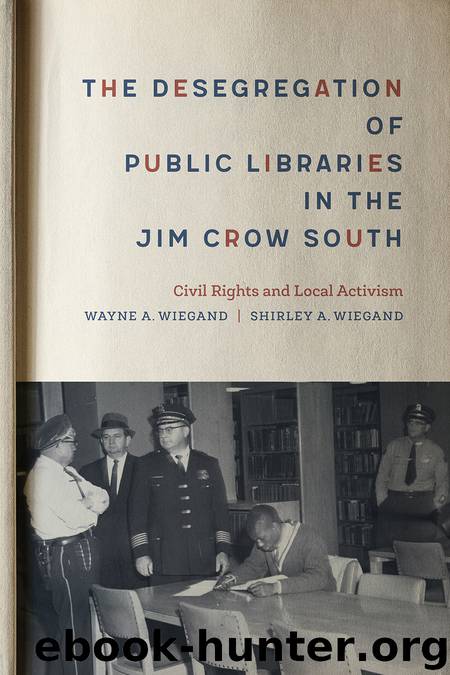The Desegregation of Public Libraries in the Jim Crow South by Shirley A. Wiegand

Author:Shirley A. Wiegand
Language: eng
Format: epub
Publisher: LSU Press
Published: 2018-03-04T16:00:00+00:00
COLUMBUS
While Albany Movement organizers used scattered protests and demonstrations against all forms of local segregation, including at the public library, protesters in Columbus were more focused. Without incident, at 5:35 p.m. on July 5, 1963, one male and six female black youths between the ages of thirteen and seventeen occupied two tables at the white W. C. Bradley Memorial Library. Other patrons said, and did, nothing. Shortly after six, however, seventeen-year-old Cleophas Tyson, president of the NAACP Youth Council’s Columbus Chapter, and fifteen-year-old Gwendolyn Smyre left the room to call a wire news service in Atlanta. At 6:45 the remaining five girls left the library, but when they returned at 7:00 with Tyson and Smyre, two library employees blocked the door. Five minutes later the director intervened, and while he talked with the teenagers, other white patrons entering and exiting the building expressed their displeasure at having to walk around them. Tyson asked the librarian to recommend to the local board of education exercising authority over the library that it desegregate the facility. The librarian said he would not initiate a request, but he would recommend library integration if the group—“in a proper manner”—asked for a meeting with the board to discuss their request. The librarian then allowed the group to enter the library but closed it for all other patrons.42
Three days later, another group of twelve male and three female black teenagers entered the library at 2:00 p.m., took books from the shelves, sat at tables (several left to make phone calls), then approached the circulation desk one by one and surrounded it. When asked to step aside to allow white patrons to check out books—librarians argued they “stood as close to each other as they could to block the counter”—they refused. Librarians denied them library cards, refused to check out books they brought to the desk, and told them to use the Fourth Avenue Negro library. Instead, teenagers peppered the librarian with questions. Soon police arrived. “They just stood there,” the police chief said later. “I read them the state law on unlawful assembly and told them to leave and there would be no case made against them. They just looked at me and said nothing.” Because they refused to move, he reasoned, “they were creating a disturbance.” Police arrested three (one girl had reportedly “bumped” several white patrons trying to access the circulation desk), and charged four with unlawful assembly in what the city’s major newspaper, the Columbus Ledger, called a “read-in”—a direct action term that now joined sit-in, kneel-in, vote-in, ride-in, and swim-in in the lexicon of civil rights activists.
At the hearing, their lawyer argued, “There is no law whereby the people in the library have a right to refuse service because of a person’s race.” When he asked the assistant librarian why he had refused these teenagers cards, the librarian said it was because they were black. “Then the refusal to issue library cards to the Negroes . . . was based entirely on their
Download
This site does not store any files on its server. We only index and link to content provided by other sites. Please contact the content providers to delete copyright contents if any and email us, we'll remove relevant links or contents immediately.
| General | Discrimination & Racism |
Nudge - Improving Decisions about Health, Wealth, and Happiness by Thaler Sunstein(7615)
iGen by Jean M. Twenge(5366)
The Fire Next Time by James Baldwin(5248)
Adulting by Kelly Williams Brown(4487)
The Hacking of the American Mind by Robert H. Lustig(4318)
The Sports Rules Book by Human Kinetics(4290)
The Ethical Slut by Janet W. Hardy(4172)
Captivate by Vanessa Van Edwards(3795)
Mummy Knew by Lisa James(3632)
In a Sunburned Country by Bill Bryson(3481)
The Worm at the Core by Sheldon Solomon(3435)
Ants Among Elephants by Sujatha Gidla(3417)
The 48 laws of power by Robert Greene & Joost Elffers(3023)
Suicide: A Study in Sociology by Emile Durkheim(2971)
The Slow Fix: Solve Problems, Work Smarter, and Live Better In a World Addicted to Speed by Carl Honore(2947)
Humans of New York by Brandon Stanton(2835)
The Tipping Point by Malcolm Gladwell(2827)
Handbook of Forensic Sociology and Psychology by Stephen J. Morewitz & Mark L. Goldstein(2658)
The Happy Hooker by Xaviera Hollander(2654)
